
HPU2. Nat. Sci. Tech. Vol 03, issue 03 (2024), 60-69.
HPU2 Journal of Sciences:
Natural Sciences and Technology
Journal homepage: https://sj.hpu2.edu.vn
Article type: Research article
Received date: 23-9-2024 ; Revised date: 28-10-2024 ; Accepted date: 08-11-2024
This is licensed under the CC BY-NC 4.0
60
On the second-order sufficient optimality condition in nonconvex
multiobjective optimization problems
Van-Tuyen Nguyen
a*
, Thi-Yen Nguyen
b
a
Hanoi Pedagogical University 2, Vinh Phuc, Vietnam
b
Phenikaa University, Hanoi, Vietnam
Abstract
The study of second-order optimality conditions is one of the most important topics in optimization
theory and attracting the attention and interest of many authors. In this paper, we introduce a novel
solution concept called “essential local efficient solutions of second-order” for nonconvex constrained
multiobjective optimization problems. We then show that the new solution concept is stronger than the
quadratic growth condition and under a mild constraint qualification, these solution concepts are
equivalent. By using the second subderivative, we derive a sufficient optimality condition for a
feasible solution to become an essential local efficient solution of second-order for the considered
problem. Examples are provided to illustrate the obtained results.
Keywords: Essential local efficient solutions of second-order, second subderivative, second-order
sufficient optimality condition
1. Introduction
Second-order optimality conditions have long been recognized as an important tool in
optimization theory and, in recent years, have been developed rapidly, see, for example [1]–[16]. It is
well known that first-order optimality conditions are usually not sufficient for optimality except in the
case of convex optimization problems. Second-order optimality conditions not only complement first-
order ones in eliminating non-optimal solutions, but they also provide criteria for recognizing the
optimality at a given feasible solution.
*
Corresponding author, E-mail: nguyenvantuyen83@hpu2.edu.vn
https://doi.org/10.56764/hpu2.jos.2024.3.3.60-69

HPU2. Nat. Sci. Tech. 2024, 3(3), 60-69
https://sj.hpu2.edu.vn 61
In this paper, we will focus on second-order sufficient optimality conditions for the following
constrained multiobjective optimization problem
Min : ( ) ,
m
f x g x C
(MP)
where :
n m
f
and :
n p
g
are twice continuously differentiable mappings, and
n
C
is a
nonempty and closed set. When
1,
m
the above problem is called a mathematical program problem
and is denoted by (P).
The study of second-order optimality conditions for (P), when
C
is convex, has been completely
developed by Bonnas and Shapiro [1], Cominetti [2], Rockafellar and Wets [12], Mohammadi et al.
[10], etc. More precisely, if C is convex polyhedral, second-order optimality conditions can be
expressed in term of second derivative of the Lagrangian, see, for example [1], [12]. If C lacks the
polyhedrality, then an additional term is needed to capture the curvature of C and there are various
tools that can be utilized for such purpose, see [2], [10].
Recently, several important problem classes which can be reformulated in the form of problem
(P) with non-convex
,
C
such as, the mathematical program with complementarity constraints, the
mathematical program with semi-definite cone complementarity constraints, etc. have attracted
significant attention from the optimization community, see [17]–[20]. In these papers, the authors use
the so-called lower generalized support function and the second subderivative to derive necessary and
sufficient optimality conditions for (P) with
C
nonconvex. However, to the best of our knowledge, no
papers have yet investigated second-order optimality conditions for multiobjective optimization
problems of the form (MP). Motivated by the works reported in [11], [17], [18], in this paper, we
introduce a new solution concept called “essential local efficient solutions of second-order” for the
problem (MP) and study the sufficient optimality condition for the proposed solution.
We organize the paper as follows. Section 2 contains the preliminaries and auxiliary results. In
Section 3, we present a second-order sufficient optimality condition for a feasible solution to be an
essential local efficient solution of second-order to (MP). Section 4 provides some concluding
remarks.
2. Preliminaries
Throughout this work we deal with the Euclidean space
n
equipped with the usual scalar
product
,
and the corresponding norm
.
We denote by
r
B x
the open ball centered at
x
with
radius
.
r
The set of all positive integer numbers is denoted by
.
Let
be a nonempty subset in
.
n
The closure, interior, convex hull, and conic hull of
are denoted, respectively, by cl
, int
, conv
, and cone
.
The distance
dist ,
x
from a point
n
x
to
is defined by
dist , : inf : .
n
x y x y x
The indicator function
and the support function
of
are defined, respectively, by
* *
sup , : ,
z z z z
0 if ,
otherwise.
x
x
Definition 2.1. Let
n
,
,
z
and
.
n
u

HPU2. Nat. Sci. Tech. 2024, 3(3), 60-69
https://sj.hpu2.edu.vn 62
(i) The set tangent/contingent cone to
at
z
is defined by
: : 0, with .
n
k k k k
T z u t u u z t u k
(ii) The second-order tangent set to
at
z
with respect to the direction
u
is defined by
2 2
1
( , ) : : 0, , , .
2
n k k
k k k
T z u v t v v z t u t v k
Remark 2.2. It is well-known that
T z
is a nonempty closed cone. For each
,
n
u
the set
2
( , )
T z u
is closed and 2( , )T z u
if
.
u T z
However, we see that the set
2( ,0)
T z T z
is
always nonempty. If
is convex, then we have
( ) cl : ( ), , 0 ,
T z d d x z x
and for each
u T z
one has
2
( , ) cl cone[ cone( ) ].
T z u z u
Moreover, if
is a polyhedral convex set, then we have
2
( )
( , ) ( ).
T z
T z u T u
Definition 2.3. Let
.
n
w
For
, 0,
,
: 0 : || || || || || |||| ||
V w w B w w w w w w
is called a directional neighborhood of direction
.
w
Definition 2.4. Let
n
,
,
z
and
.
w T z
The proximal prenormal cone
,
p
z w
and
the proximal normal cone
,
p
N
z w
to
at
z
in the direction
w
are defined, respectively, by
* * 2
,
, : : , , 0 such that , || || ,
pn
z w z z z z z z z z V w
, : , .
pp
N
z w z w w
If
,
w T z
we define
, , .
pp
N z w z w
Definition 2.5. Let
: : ,
n
be an extended real-valued function and
n
z
such
that
z
and *
.
n
z
(i) The subderivative of
at
z
is defined by
0,
d : liminf .
n
t
w w
z tw z
z w w
t
(ii) The second subderivative of
at
z
for
*
z
is defined by
*
2 *
2
1
02
,
d , : liminf .
n
t
w w
z tw z t z w
z z w w
t
Remark 2.6. (see [12]) (i) The second subderivative has the homogeneity property, i.e.,

HPU2. Nat. Sci. Tech. 2024, 3(3), 60-69
https://sj.hpu2.edu.vn 63
*
2 * 2
d , d , 0,
z
z z w z w
and
* 2 *
d , d , ,
z w z w z z w
* 2 *
d , d , .
z w z w z z w
(ii) If
is twice differentiable at
z
and
*
,
z z
then we have
2 2
d , .
T n
z z w w z w w
(iii) Let
n
,
,
z
and *
.
n
z
Then, by definition, we have
* *
2 *
2
1
0 0,
2
, 2 ,
d ; liminf liminf .
t t w w
w w z t w
z tw z t z w z w
z z w t t
We now summarize some properties of the second subderivative that will be used in the next
section.
Lemma 2.7. (see [17, Lemma 2.7]) Let :n
be a lower semicontinuous function and
n
z
such that
z
and *
.
n
z
Then there exist sequences 0 and
k k
t w w
such that
d lim k k
kk
z t w z
z w t
,
*
2 *
2
1
2
,
d , lim .
k k k k
kk
z t w z t z w
z z w t
Lemma 2.8. (see [18, Proposition 2.18]) Let
n
,
,
z
and *
, .
n
z w
The following
statements hold:
(i) If
w T z
or *
, 0,
z w
then
2 *
d ; .
z z w
(ii) For
,
w T z
2 *
d ;z z w
iff
*
, .
p
w
z z
(iii) If
2 *
d ;
z z w
is finite, then
*
, .
p
w
N zz
(iv)
2
2 * *
,
d ; T z w
z z w z
iff
w T z
and *
, 0
z w
or
2
, .
T z w
3. Second-order sufficient optimality conditions
Consider the following constrained optimization problem
Min : ( ) ,
m
f x g x C
(MP)
where :
n m
f
and :
n p
g
are twice continuously differentiable mappings with
1
: , , ,
m
f x f x f x
1
: , , ,
p
g x g x g x
and
n
C
is a nonempty and closed set.
The feasible set of (MP) is denoted by

HPU2. Nat. Sci. Tech. 2024, 3(3), 60-69
https://sj.hpu2.edu.vn 64
1
: : .
n
S g C x g x C
We always assume that
S
is nonempty. We say that
u
is a critical direction of problem (MP) at
x S
if
, ,
, 0, : 1, , .
C
iu
x
f
x
x
g u T g
i I m
The set of all critical directions of (MP) at
x S
is denoted by
.
K
x
We say that the set-valued
mapping
x
g x C
is metrically subregular at
, 0
x in direction
n
u
if there exist
, , 0
such that
,
.
d ,ist , distx g x C x xS
V u
The generalized Lagrangian :n m p
L
with respect to the problem (MP) is given as
, , : , , .
L x f x g x
We now introduce the concept of essential local efficient solutions of second-order for (MOP)
inspired by the work of Penot [11].
Definition 3.1. Let
.
x S
We say that:
(i)
x
is a local efficient solution of (MP) if there exists
0
such that there is no
x S B
x
satisfying
\ 0 .
m
f x xf
(ii)
x
satisfies the quadratic growth condition if there exist two positive numbers
0
and
0
such that
1 1
2
: max , , .
m
x f x f f x xx x xf
x
x S B
(iii)
x
is an essential local efficient solution of second-order for problem (MP) if there exist two
positive numbers
0
and
0
such that
1 1
2
: max , , , dist , .
m
x x xx f x f f x f g x C x x B
x
The following result gives the relationships between above solution concepts.
Proposition 3.2. Consider the following statements:
(i)
x
is a local efficient solution of (MP).
(ii)
x
satisfies the quadratic growth condition.
(iii)
x
is an essential local efficient solution of second-order for problem (MP).
Then the implications (iii)
(ii) and (ii)
(i) always hold. Furthermore, if the mapping
x
g x C
is metrically subregular at
, 0
x in every critical direction
\ 0 ,
u K x then the
implication (ii)
(iii) is also valid.
Proof. (iii)
(ii): The proof follows immediately from the definitions.
(ii)
(i): Suppose, for the sake of contradiction that
x
satisfies the quadratic growth condition
but not is a local efficient solution of (MP). Then, by definition, there exist two positive numbers


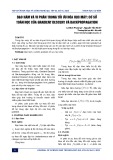
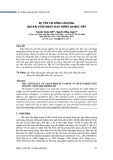
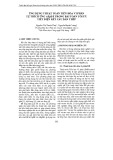
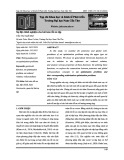
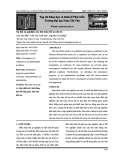

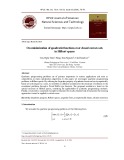
















![Quyển ghi Xác suất và Thống kê [chuẩn nhất]](https://cdn.tailieu.vn/images/document/thumbnail/2025/20251030/anh26012006/135x160/68811762164229.jpg)
